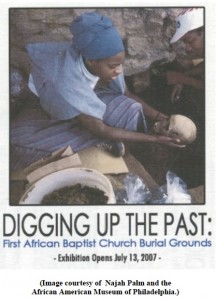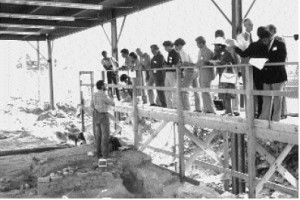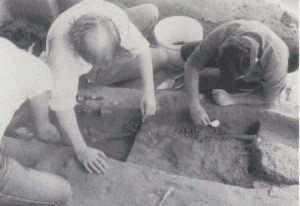Research And Reporting On Archaeological Burials In Philadelphia….
PAF Home
Back to Burial Places/Cemetery Issues
*************************************************************************
A Distinct Church of the Lord Jesus”: The History, Archeology, and Physical Anthropology of the Tenth Street First African Baptist Church Cemetery, Philadelphia, Pennsylvania, Site Number 36 PH 72, Vine Expressway (1-676), L.R. 67045, ER# 82-0133-101-W
Prepared for Gaudet & O’Brien Associates/Urban Engineers, Incorporated 300 North 3rd Street, Philadelphia, Pennsylvania 19106-1193 and Department of Transportation, Commonwealth of Pennsylvania, Engineering District 6-0, 200 Radnor-Chester Road, St. Davids, Pennsylvania 19087. By Thomas A.J. Crist, Reginald H. Pitts, Arthur Washburn, John P. McCarthy, Daniel G. Roberts, with Contributions By Molly A. Hickey and Rashid M. Humphrey, John Milner Associates, Inc., 1216 Arch Street, 5th Floor, Philadelphia, Pennsylvania 19107. 1996
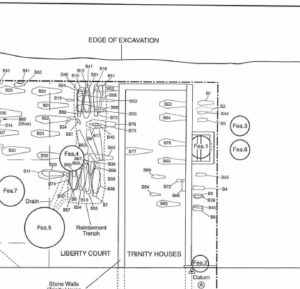
This is the final report prepared for an archeological data recovery project conducted in 1990 at the site of a former cemetery used by the First African Baptist Church between 1810 and 1822. The site was excavated as part of the Vine Street Expressway (I-676) Construction Project, undertaken by the Pennsylvania Department of Transportation and the Federal Highway Administration. The skeletal remains and funerary artifacts of 89 African-American individuals recovered from the site — individuals associated with the earliest free African-American Baptist congregation in Philadelphia — revealed important information on the demography, health quality, prevalence of disease and trauma, patterns of physical stress, and levels of nutritional adequacy for a group of people about which little historical documentation exists. Analysis of the burial practices at the cemetery revealed the incorporation of Christian mortuary traditions into the African American funerary rite, links between the funeral industries in England and Philadelphia during the early 19th century, and the marginal economic position of this segment of early Philadelphia society. “The historical development of the Church was found to reflect the attempts by early African Americans in Philadelphia to establish their own identity within an Anglicized society and to foster social institutions that supported African-American self-sufficiency and social cohesion. The cemetery project reported here is the successful result of a partnership between public agencies, private companies, archeologists and physical anthropologists, and members of the descendant community. [Due to its size, this report is not accessible directly online at this time. Please contact pljeppson@gmail.com, the PAF web Master, to request a copy be emailed.
*************************************************************************
The Washington Avenue Project
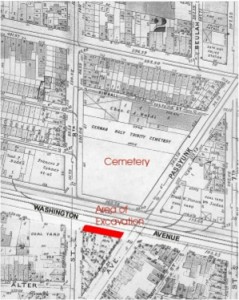
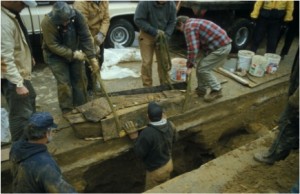
On October 22, 2001, along the 700 block of Washington Avenue in south Philadelphia, construction workers exposed human remains and several wooden coffins during a routine project to install a new city water line as part of a street repaving project. Two reports resulting from this project are posted here. One report, PARTNERING IN A SOUTH PHILADELPHIA DIG: THE WASHINGTON AVENUE BIOARCHAEOLOGY PROJECT, is drawn from a formal poster by A. Washburn, T.A. Christ, M.B. Goldberg, and M. Kirkpatrick that was presented at the 2007 Meeting of the American Association of Physical Anthropologists. The Second, Summary of Archaeological Salvage of Burials, Washington Avenue, Philadelphia, is referenced here as The Washington Avenue Project, which is how the project is known within the archaeology community. This report was completed by Dr. R. Michael Stewart of Temple University. The report appendixes include a skeletal analysis by Dr. T. Thomas Crist, and a dental analysis by Dr. Art Washburn.
*Philadelphia Inquirer Archives are now behind a paywall.
Historical remains to be moved to vault: Reburial of 200-year-old bodies needs judge’s OK. Colimore, E. March 25, 2005, The Philadelphia Inquirer.
What to do about the historic remains that lie beneath?, Dilanian, K. February 24, 2002, The Philadelphia Inquirer.
****************************************************************************************
Bethel Burial Ground (Weccacoe Park, Queen Village)
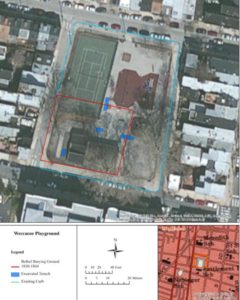
Archaeological Report: Phase IB Archaeological Investigations of the Mother Bethel Burying Ground, 1810 – Circa 1864 (80 pages, large pdf file) ER No. 2013-1516-101-A, Prepared for the Pennsylvania Horticultural Society by Douglas Mooney and Kimberly Morrell of URS Corporation, October 11, 2013. Archaeological Report Appendixes (84 pages, large pdf file) The Appendices include:
Appendix A: Potter’s Field and Almshouse Cemeteries in Philadelphia
Appendix B: Hallowed Ground: African American Petitions and Philadelphia’s Potter’s Field
Appendix C: African American Cemeteries in Philadelphia, 1797–1849 (African American Churches and Burial Grounds, 1780–1849)
Appendix D: Test Trench Plan and Profile Maps (Bethel Burial Ground)
Appendix E: Artifact Tables
Appendix F: Artifact Catalog
Appendix G: Bureau of Historic Preservation Archaeological Report Summary Form
Appendix H: Mother Bethel Burying Ground PENNSYLVANIA ARCHAEOLOGICAL SITE SURVEY PENNSYLVANIA HISTORICAL AND MUSEUM COMMISSION Form
*Read news coverage under heading AME Burial Ground/Weccacoe Park…
**********************************************************************************
Germantown Potter’s Field/Queen Lane Redevelopment Project
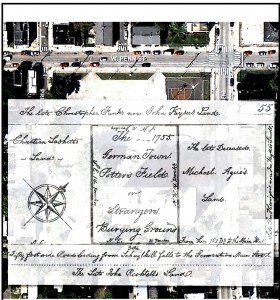
The Philadelphia Archaeological Forum was a Consulting Party to the Philadelphia Housing Authority’s Queen Lane development in Germantown. The project involved development in the location of the 1755 Germantown Potter’s Field, or Stranger’s Burial Ground. Learn more about this project and read The Queen Lane Phase I Archaeological Survey, Geophysical Survey (Grave Detection Delineation Beneath Paved Parking Lot) and Ground Penetrating Radar Survey Results here…
Archaeological Dig at Germantown Potter’s Field Site will not start before March
01/25/2012, Newsworks
Queen Lane Apartments demo in limbo as archaeologists, historic-preservation experts plan Potter’s Field visit
Three Possible Grave Sites discovered at Potter’s field site in Germantown
July 13, 2012, Newsworks WHYY
Underground Search of the Potter’s Field in Germantown commences
April 11, 2012, Newsworks WHYY
***************************************************************************************************
Old First Reformed Church of Philadelphia
(Franklin Square, Race Street between 6th & 7th)
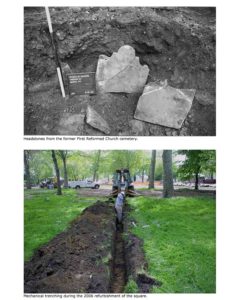
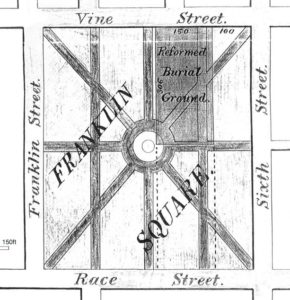
This church burial ground and the reuse of its headstones are reported on in this 2005 report prepared by archaeologists from John Milner Assoc., Inc.
An Archeological Sensitivity Study of Franklin Square, Philadelphia Pennsylvania Leaving No Stone Unturned: Archeological Monitoring and the Transformation of Franklin Square
***************************************************************************************************
2007 Digging Up the Past: An Exhibit Review [PDF format]. This review presents an archaeological perspective on the First African Baptist Church Burial Grounds exhibit at the African American Museum of Philadelphia (AAMP). The exhibit drew upon archaeological studies at two African Baptist Church burial grounds re-discovered and destroyed in the construction of the Vine Street Expressway. Written by historical archaeologist Patrice L. Jeppson, this article was published in the September 2007 issue of the African Diaspora Archaeology Newsletter.
***************************************************************************************************
1996 Engaging the Public Through Mortuary Archeology: Philadelphia’s First African Baptist Church Cemeteries . This article by physical anthropologist Thomas A. J. Crist and archaeologist Daniel G. Roberts was published in 1996 in the government publication, CRM (No. 10 — 1996, Vol. 9, pages 5-7).
***************************************************************************************************

1998 Plates in Graves: An Africanism? Archaeologist John P. McCarthy prepared these comments for a panel discussion entitled ‘Lessons from Historic Period Cemeteries’. It includes data on Philadelphia’s First African Baptist Church Cemeteries. The talk was held at the 1998 Meeting of the Society for Historical Archaeology, Atlanta.
***************************************************************************************************
1986 Acculturation in an Urban Setting: The Archaeology of a Black Philadelphia Cemetery” [PDF format, 4.3MB], by Michael Parrington; Janet Wideman, 1986, Volume 28(1), Pages 55-62.
***************************************************************************************************
The Good, the Bad, and the Ugly:
Bioarchaeology and the Modern Gun Culture Debate
[*PAGES 118-119 of which report and analyze gunshot victims in the Philadelphia archaeological record, namely ca. 1750–1799 burials at the Second Presbyterian Church Burial Ground excavated during construction of the National Constitution Center and from the First African Baptist Church Burial Ground, dating between ca. 1810 and 1822, discovered in the 1990’s during construction of the Vine Street Expressway.
By Thomas A. Crist
Historical Archaeology, 2006, 40(3):109–130.
In this article, Crist considers “personal gun ownership during the early history of what is now the United States that lies at the root of the modern argument between supporters of gun control and those whose interpretation of the Second Amendment endows private citizens with the right to keep and bear arms”. Using historical evidence, including from early burials in Philadelphia, he shows that with growing gun ownership, during and after the 1830s, “an ever-increasing number of homicides (have) resulted from gunfire, particularly in the large cities” (Crist, HISTORICAL ARCHAEOLOGY 40(3):126.

by admin
